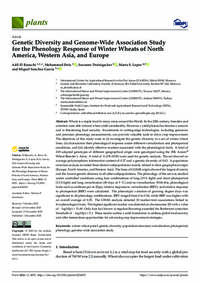Genetic Diversity and Genome-Wide Association Study for the Phenology Response of Winter Wheats of North America, Western Asia, and Europe

Authors:
Wheat is a staple food in many areas around the World. In the 20th century, breeders and scientists were able to boost wheat yield considerably. However, a yield plateau has become a concern and is threatening food security. Investments in cutting-edge technologies, including genomics and precision phenology measurements, can provide valuable tools to drive crop improvement. The objectives of this study were to (i) investigate the genetic diversity in a set of winter wheat lines, (ii) characterize their phenological response under different vernalization and photoperiod conditions, and (iii) identify effective markers associated with the phenological traits. A total of 249 adapted genotypes of different geographical origin were genotyped using the 35K Axiom® Wheat Breeder’s Array. A total of 11,476 SNPs were used for genetic analysis. The set showed an average polymorphism information content of 0.37 and a genetic diversity of 0.43. A population structure analysis revealed three distinct subpopulations mainly related to their geographical origin (Europe, North America, and Western Asia). The lines of CGIAR origin showed the largest diversity and the lowest genetic distance to all other subpopulations. The phenology of the set was studied under controlled conditions using four combinations of long (19 h light) and short photoperiod (13 h light) and long vernalization (49 days at 5 °C) and no vernalization. With this, phenological traits such as earliness per se (Eps), relative response to vernalization (RRV), and relative response to photoperiod (RRP) were calculated. The phenotypic variation of growing degree days was significant in all phenology combinations. RRV ranged from 0 to 0.56, while RRP was higher with an overall average of 0.25. The GWAS analysis detected 30 marker-trait associations linked to five phenological traits. The highest significant marker was detected on chromosome 2D with a value of −log10(p) = 11.69. Only four loci known to regulate flowering exceeded the Bonferroni correction threshold of −log10(p) > 5.1. These results outline a solid foundation to address global food security and offer tremendous opportunities for advancing crop improvement strategies.
